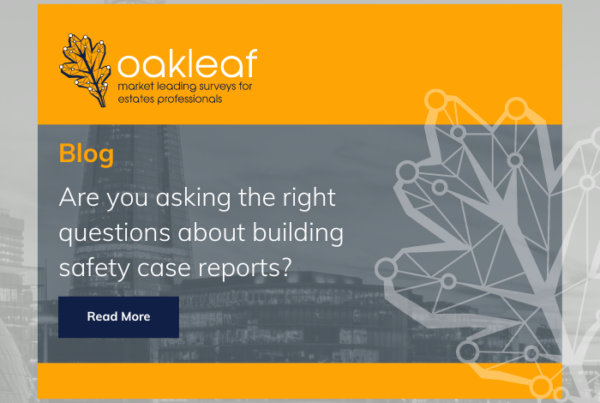The Building Safety Act 2022: What you need to know
The Building Safety Act received Royal Assent on the 28th April 2022 and is now law; it is a 230-page Act which intends to ensure building safety is held paramount.
The Act requires more stringent safety measures and will change the way residential buildings are constructed and maintained for generations to come. Although the Act is now law, many of the provisions will only come into ‘force’ when secondary legislation has been formed. It is expected that the industry and those Responsible Persons are now preparing for the new regime and are actively taking action to implement the relevant statutory requirements.
The Act comprises of six parts and is applicable to all buildings but also includes requirements specific to ‘higher-risk’ buildings; that is buildings which are at least 18m in height or have at least seven storeys and which are specified as in-scope by the Secretary of State, currently residential, hospital and student accommodation.
The Act allows for the implementation of specific ‘Gateways’ or key decision points to ensure that building safety risks are considered during each phase of new build construction, from planning to construction, and handover to occupation. Gateway One is already in place and requires the submission of a Fire Statement along with the Planning Application for proposed residential buildings having two or more dwellings and seven or more storeys, or which are 18m or more in height.
What’s included within the Building Safety Act?
- Function and duties of the Building Safety Regulator
- Defines who an Accountable Person is and their responsibilities
- Requirement to establish a building Resident’s Panel
- Production of a Safety Case Report for an occupied higher-risk building
- Amendments to the Building Act 1984
- Requirement for higher-risk buildings to have a Building Assessment Certificate
- Reporting, sharing and maintaining information (Golden Thread)
How will the new Building Safety Act work?
The Building Safety Regulator – Health and Safety Executive
The Building Safety Act names the Health and Safety Executive (HSE) as the new Building Safety Regulator (BSR). The Building Safety Regulator has been introduced to oversee and regulate high-rise buildings, as described above.
The BSR has three roles:
- To oversee safety and standards of all buildings
- To help and encourage the improvement of competence
- To lead the implementation of the new High-Rise Building framework
The building safety reforms will introduce a new regulatory framework which will include formal registers of occupied high-rise buildings, building inspectors and building control approvers.
The BSR will essentially enforce the Building Safety Act, taking a consistent and proportionate approach whilst working closely with local authorities and fire and rescue authorities to ensure legislation is complied with.
The Accountable Person
All occupied higher-risk buildings will be required to have at least one clearly identifiable Accountable Person, known as the ‘Principal Accountable Person’. Should there be two or more Accountable Persons, one is to be assigned as Principal.
An Accountable Person(s) is responsible for ensuring that fire and structural safety is being properly managed for the whole building and, to avoid committing an offence, they will be required to identify themselves to the Building Safety Regulator before the building is occupied (new construction).
Accountable Persons are the organisation or person who owns or has responsibility for the building. It may also include the organisation or person who is responsible for maintaining the common parts of the building. They will need to prepare, maintain and review a resident engagement strategy that allows for relevant persons to contribute to the making of building safety decisions, for which resident’s, owners and any prescribed person are to be issued a copy of.
The Accountable Person will be required to ensure existing occupied buildings are registered with the BSR before October 2023, prepare a safety case report and apply for a Building Assessment Certificate when directed by the BSR.
Resident’s Panel
The BSR will establish a Resident’s Panel to ensure residents have a voice and may include both residents and non-resident owners. All reasonable steps are to be taken to ensure the Resident’s Panel contains representation from disabled residents.
The objective of the Resident’s Panel is to advise the BSR on matters relating to the safety of higher-risk buildings.
Safety Case
Building Owners will be responsible for assessing and managing building safety risks in high-rise residential buildings.
The safety case regime intends to ensure Accountable Persons deliver a continuous preventative and proactive approach to managing building safety risks by requiring them to identify and assess risks and then taking reasonable steps to ensure those risks are reduced and controlled to a proportionate level.
The safety case is all the information used to manage the risk of fire spread and the structural safety of a building.
Within the Safety Case, the Accountable Person must be able to:
- Provide certain types of information on the building (known as the Golden Thread)
- Identify building safety risks relating specifically to the spread of fire and structural failure
- Demonstrate how they are keeping the building safe
- Demonstrate how they believe the measures adopted are adequate
- Demonstrate the approach taken for managing safety i.e. Safety Management System (SMS)
- Produce a Safety Case Report
All information regarding a safety case must be stored electronically and does not replace any existing legal requirements.
Safety Case Report
The Safety Case Report will need to demonstrate how fire and structural safety risks that could lead to a major incident are being managed.
The Principal Accountable Person will be responsible for preparing a safety case report. They will need to include general basic building information such as when it was built, the relevant standards, building height, it’s design and construction, the fire prevention and protection measures, information on subsequent refurbishment work, number and type of flats, occupant profile and building floor plans.
Legislation regarding Safety Case Reports is still in development, a consultation on the form and its content is expected in the summer of 2022. However, HSE currently inform that the report should also contain information on the method and findings of the risk assessment, and the control measures taken. It should reference and provide an overview of the SMS, the emergency arrangements and detail how safety issues and complaints are reported. Finally, the safety case report should describe the resident engagement strategy for the building, demonstrate that all reasonable steps have been taken and inform when and how it will be reviewed.
It is not expected that the Principal Accountable Person will be able to compile all the necessary information solely by themselves. Some of the information required may not currently be present and will require competent persons to assist in the development of the prescribed information, such as fire strategies, fire risk assessments, fire risk appraisal and assessments of external walls and, or, compartmentation surveys.
Building Assessment Certificate
The Building Assessment Certificate (BAC) will apply to both existing and new buildings (having at least two residential units and being 18m in height or having at least seven storeys).
The BSR will be responsible for carrying out checks to ensure the Accountable Persons are managing building safety risks, comply with their statutory duties and are keeping residents safe. On registration of the building, the BSR will periodically assess the performance of the Accountable Person by requesting a suite of documents (Safety Case), an inspector may be sent to the building to verify the arrangements stated by the Accountable Person(s).
If the BSR is satisfied with the documents and arrangements in place, they will issue a Building Assessment Certificate. Existing buildings will be assessed over a period of the next five years, all new buildings will be assessed within six months of occupation.
Golden Thread
The ‘Golden Thread’ is information that allows someone to understand a building and keep it safe. It also describes how the information is managed to ensure it remains accurate, up-to-date, easily understandable and can be accessed by relevant persons when needed.
The Accountable Person will be responsible for coordinating, maintaining, and providing access to the golden thread of information, which will require to be in digital format. A PAS9980 report will provide a holistic view of the fire safety elements of the site.
In the design and construction of buildings (including refurbishment), duties will be placed on those who commission building work, participate in the design and construction process and those who are responsible for managing structural and fire safety in the building when it is occupied. Information will be required from those persons through the Planning Gateway process.
For existing buildings, the Principal Accountable Person will be responsible for developing and coordinating the Golden Thread (PAS9980).
The objective is to provide specific and clear information on the building and its provisions needed for the safety of the premises and its residents.; The Golden Thread is to contain the information and documents produced for building registration and certification, the safety case, mandatory occurrence reporting and resident engagement.; This information will need to be maintained throughout the lifecycle of the building.
Building Control Regime (Higher-risk Buildings: Gateways Two and Three)
A new Gateway Regime will be implemented, which will be fully introduced by October 2023. It will comprise of three new mandatory key decision points at the planning, construction and completion stages of new higher-risk buildings (including the major refurbishment of existing buildings).
Gateway One – Planning Phase
Planning Gateway One is already in place and was introduced via secondary legislation on 1st August 2021.
Gateway One requires that fire safety matters, as they relate to land use planning, are incorporated at the planning stage for schemes involving high-rise residential buildings. The fire safety considerations taken are to be submitted with the planning application in the form of a Fire Statement. The London Plan 2021 also requires that all major development proposals be submitted with a Fire Statement, regardless of height or type of premises.
The Fire Statement must be produced by competent persons such as qualified Fire Engineers.
Gateway Two – Pre-construction Phase
Gateway Two will be a ‘stop/go’ point and building control approval will be required from the Building Safety Regulator before construction work can commence. This will remove the ability to apply for retrospective planning permission.
Passing through Gateway Two will require applications to demonstrate how the proposals comply with the Building Regulations requirements. The plans and documents provided at this stage must be realistic and not reliant on ‘assumptions’ about the building when it becomes occupied.
Details on how the competency of duty holders, the production of Golden Thread information and mandatory occurrence reporting will be needed. Applicants will need to demonstrate how they will manage the construction phase and reduce the possibility of building safety risks arising.
A staged approval process is to be implemented, comprising of ‘stop/go’ points. Applicants will need to submit plans and documents for subsequent stages of construction and obtain building control approval before commencing further work.
At the date of this publication, this gateway is expected to come into ‘force’ within 12 – 18 months of Royal Assent (28th April 2022), between April and October 2023.
Gateway Three – Completion of Construction Phase
Gateway Three will occur at the completion stage of construction, it comprises of another ‘stop/go’ point; the BSR will need to provide building control approval before the higher-risk building can be registered and occupied.
To obtain approval, an application containing ‘as-built’ information will need to be submitted, this information will form part of the Golden Thread and be given to the building owner on handover of the building.
The objective is to ensure compliance and safety is considered throughout the design and construction of buildings. It will be possible for partial completion of buildings to occur, however a series of ‘stop/go’ points will be implemented.
On approval of the Gateway Three application, a building certificate will be issued, and the building registered with the Building Safety Regulator, after which, the building can be legally occupied.
At the date of this publication, this gateway is expected to come into ‘force’ within 12 – 18 months of Royal Assent (28th April 2022), between April and October 2023.
Final Thoughts
The intent of the Building Safety Act 2022 is to achieve cultural change, secure the safety of people in or about buildings and to improve the standard of buildings.
The Act provides the biggest changes in legislation for building safety since the 1980’s, with significant requirements to ensure those responsible in the design, construction and management of buildings are competent and are held to account.
The process for new construction aims to prevent loopholes being exploited and provides opportunity to ensure buildings are constructed safely and in compliance with Building Regulations. Moreover, it will provide a more environmentally and sustainable approach to construction by avoiding abortive or rectification works that may arise following ‘conditional acceptance’ or ‘refusal’ decisions made by Building Control when applicants submit retrospective planning applications.
Although existing buildings do not legally need to comply with current standards, the Act and other legislation does require them to be safe. Responsible Persons for existing higher-risk buildings will need to collate, prepare and or develop safety information on their building(s). They will need to ensure the necessary safety precautions are in place and maintained and to engage with relevant persons on matters relating to safety within or about their buildings.
Not only does the Act bring in new statutory obligations, but it amends existing legislation, including articles 5, 9, 11, 21, 22, 29, 32 and 50 of the Regulatory Reform (Fire Safety) Order 2005.
These amendments include:
- That the Responsible Persons must appoint a competent person to assist them in making or reviewing a fire risk assessment
- The requirement to provide information to residents of domestic premises
- The removal of ‘risk-based’ in article 50 widening the scope of ‘approved guidance’ that can be used to demonstrate compliance or prove a contravention of the legislation
Note: Information regarding the Building Safety Act 2022 contained on this page was correct at the time of publication but may have been superseded. Please visit https://www.legislation.gov.uk/ukpga/2022/30/contents/enacted for the most up-to-date information.
Contact us to speak to one of our professionals on how ‘The Building Safety Act’ could impact you.




 Find us on LinkedIn
Find us on LinkedIn